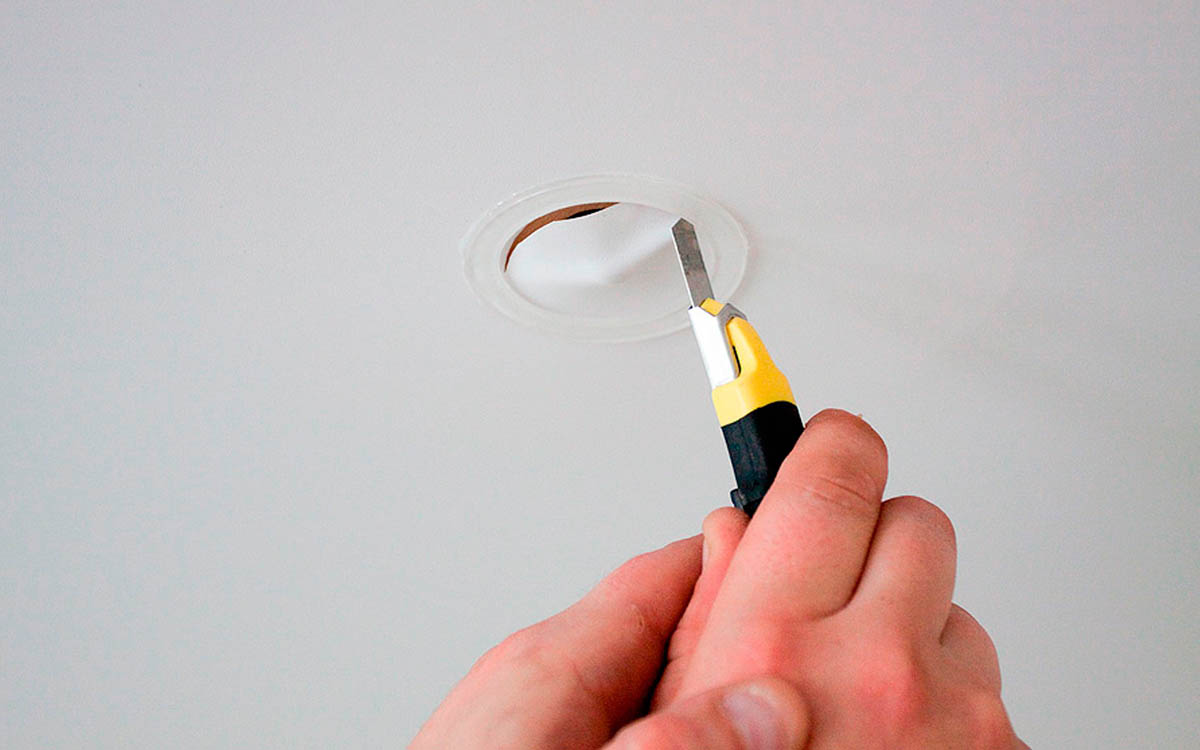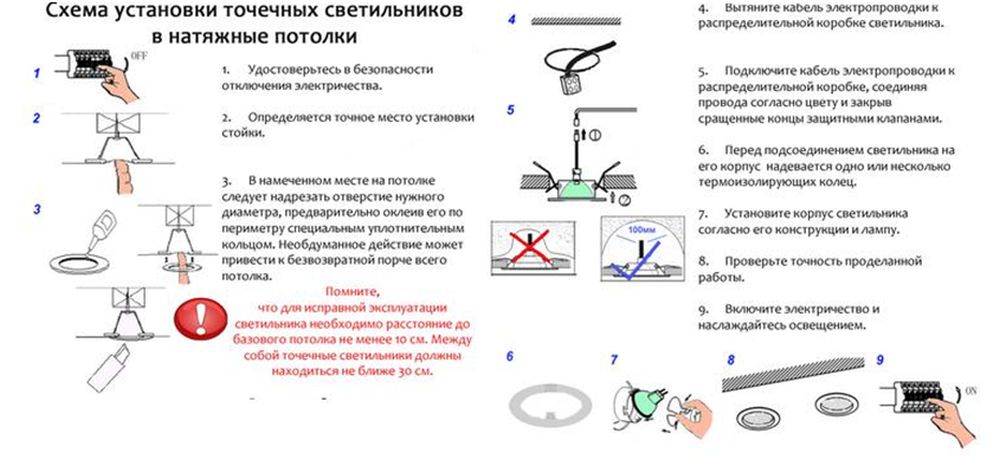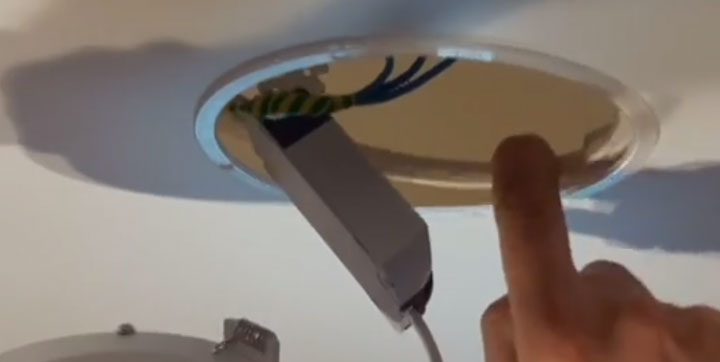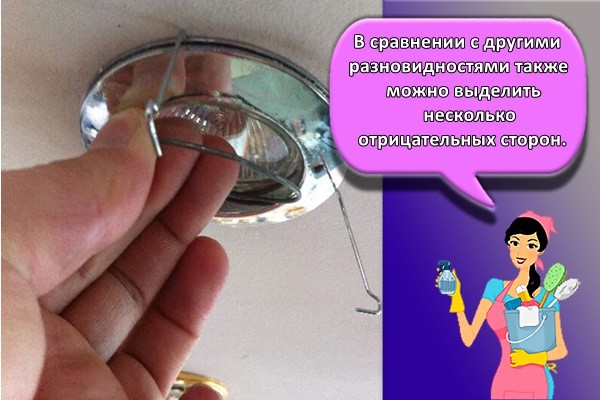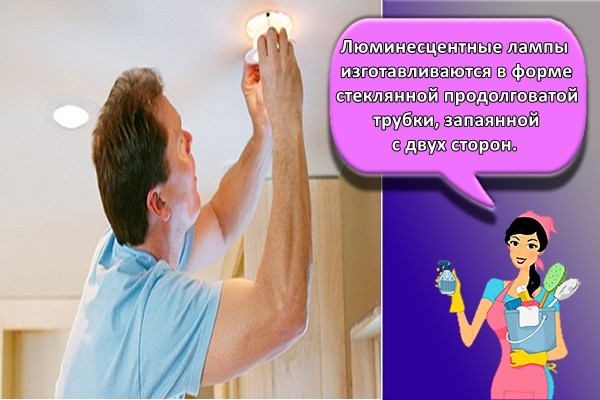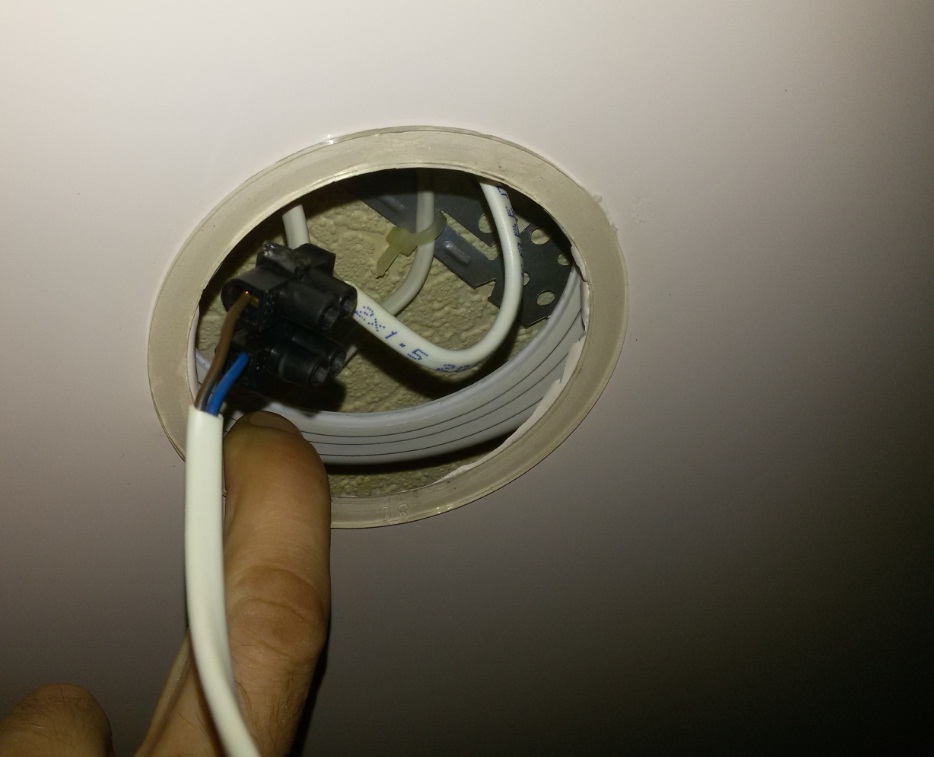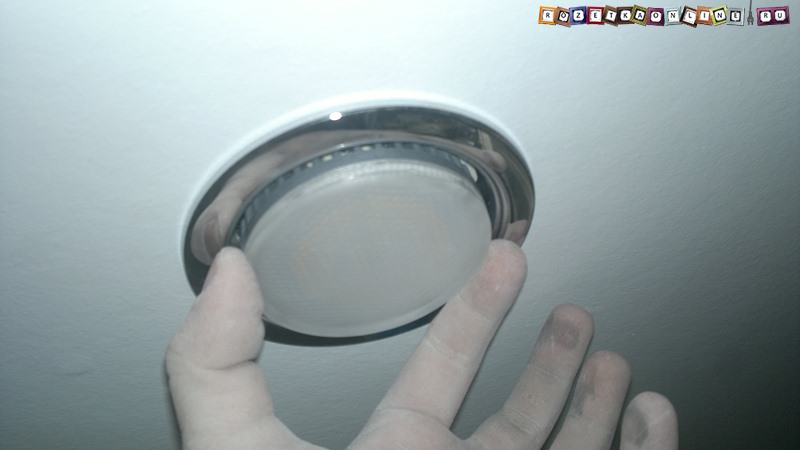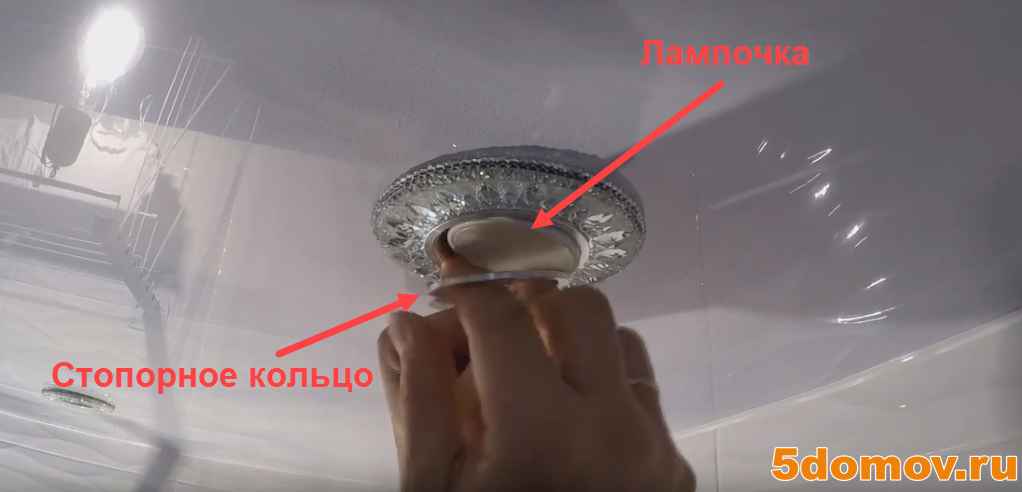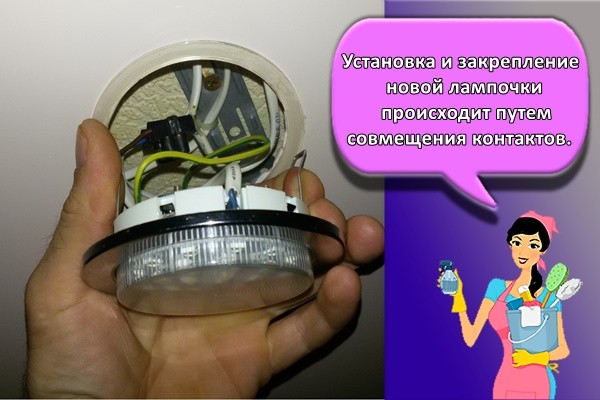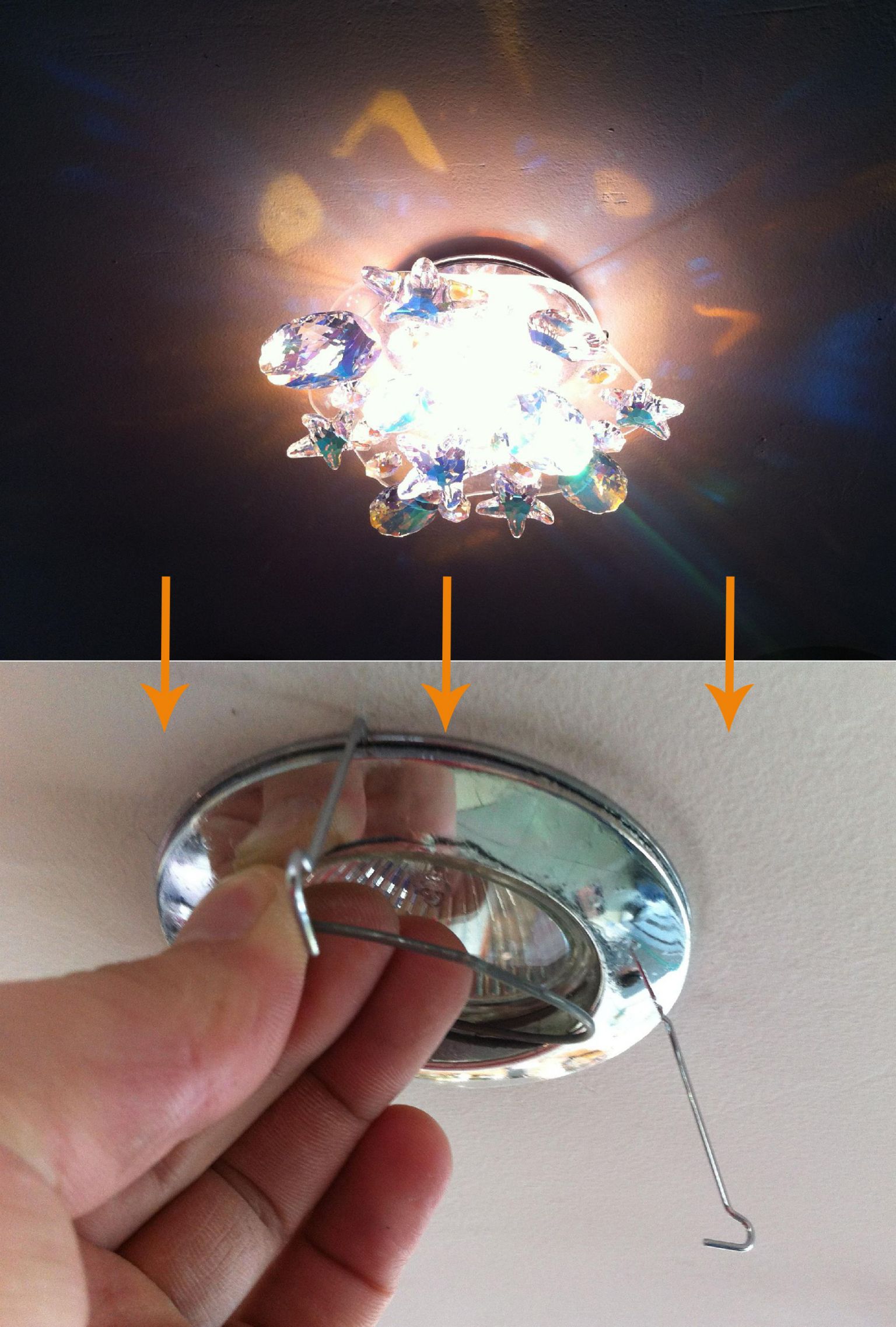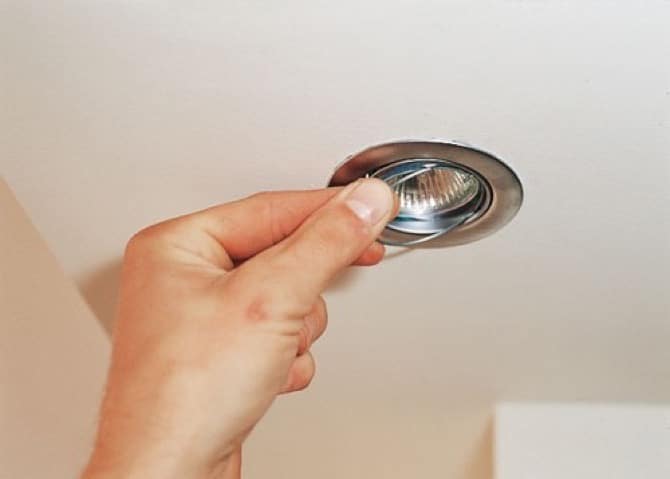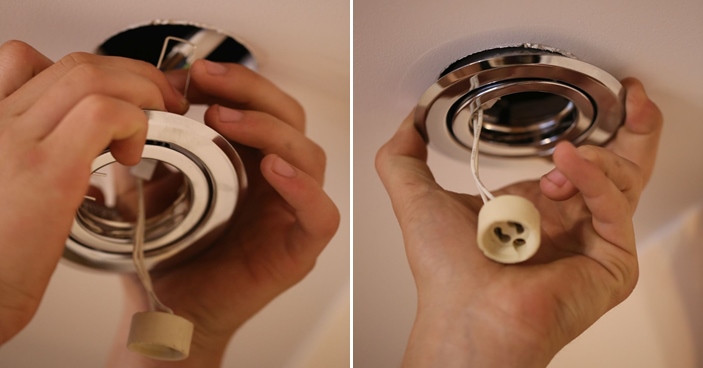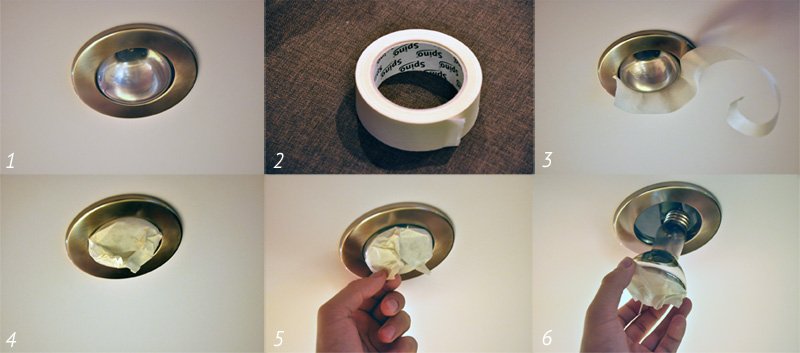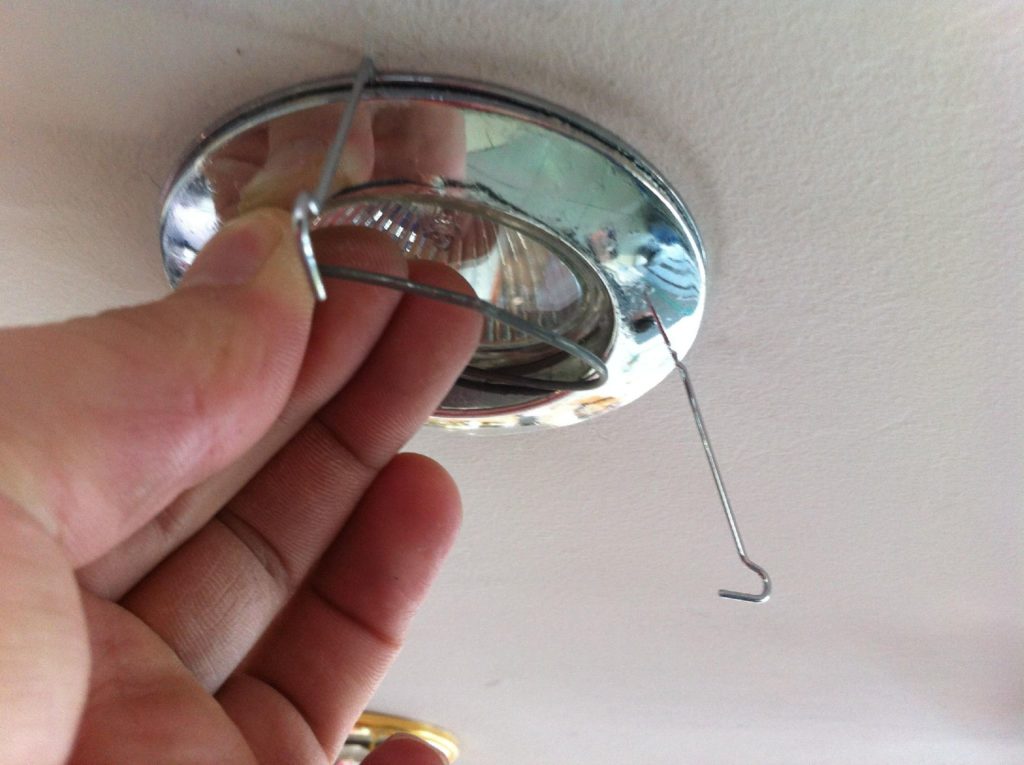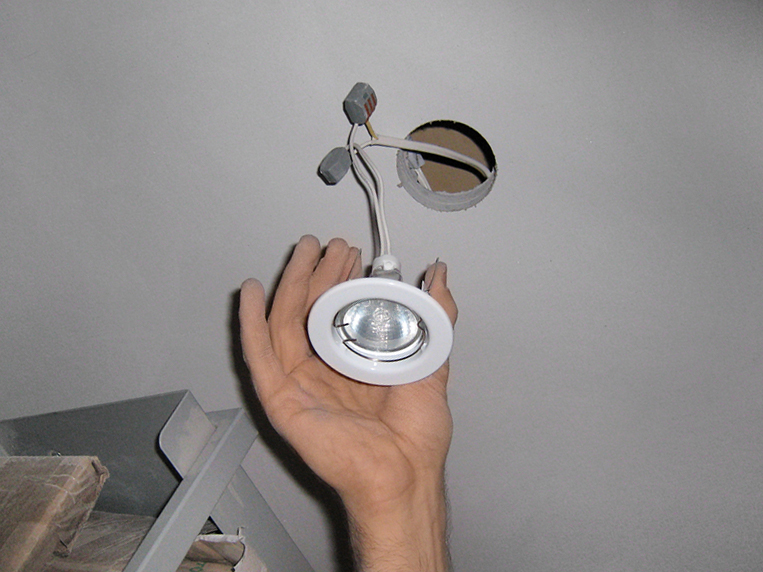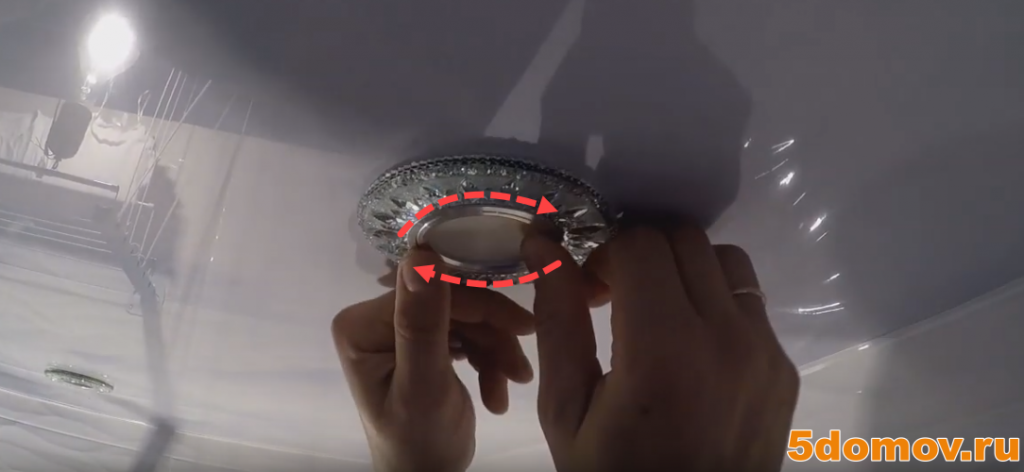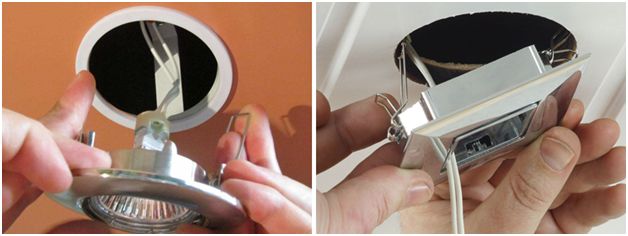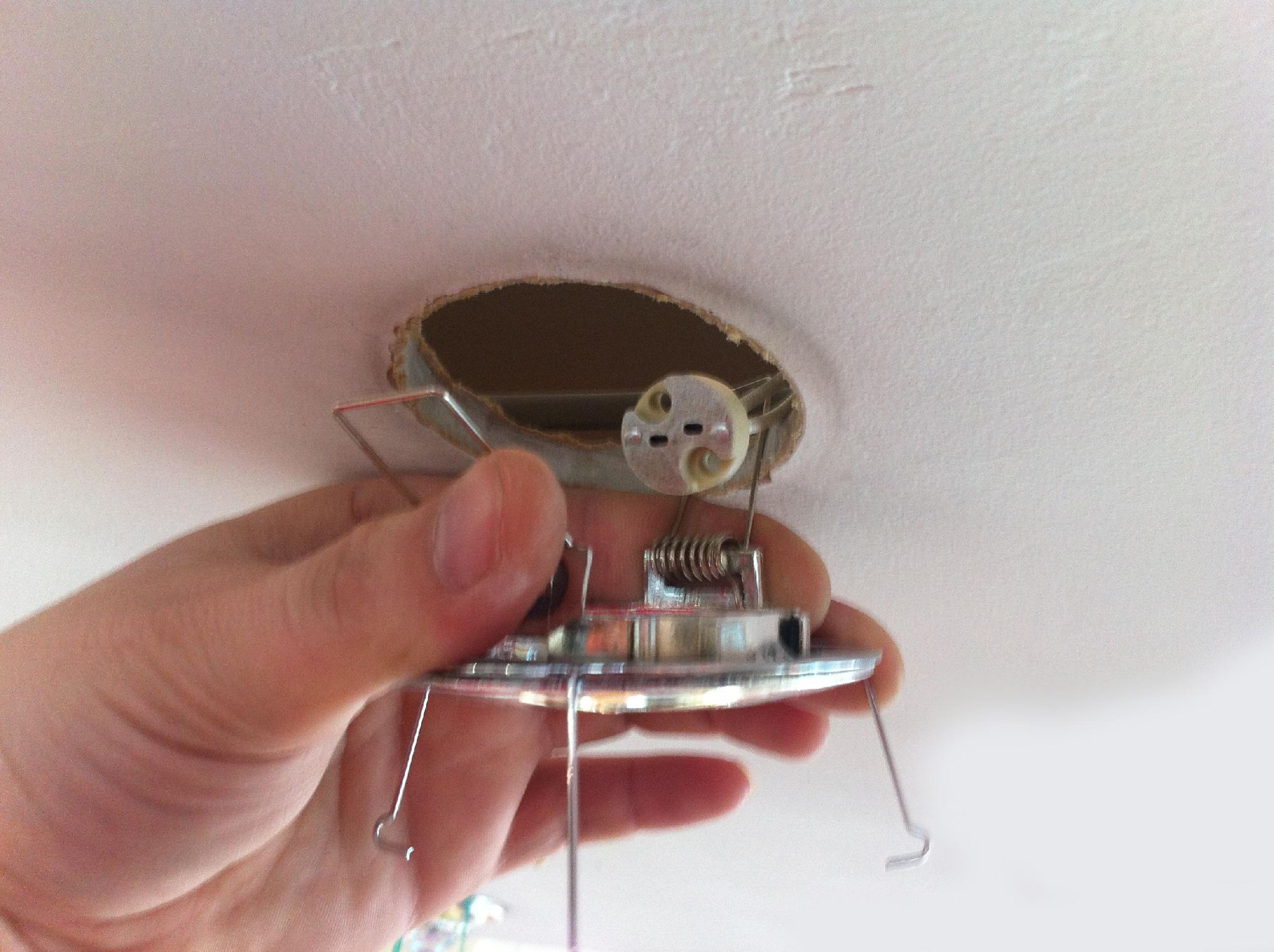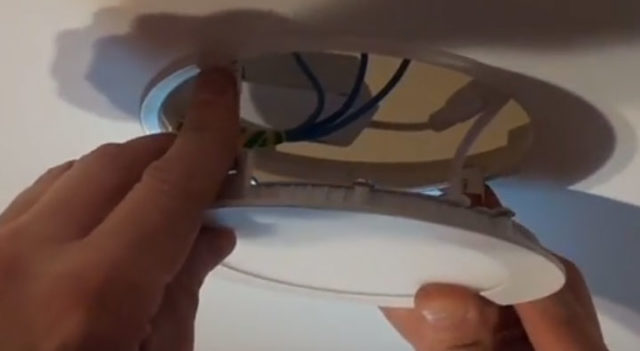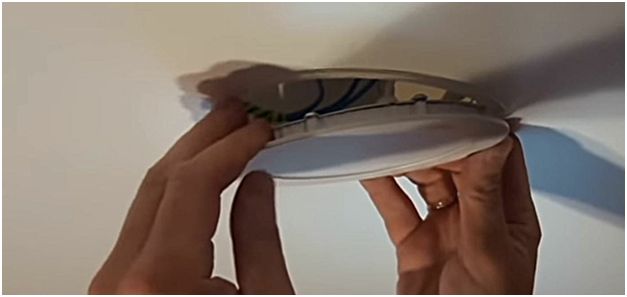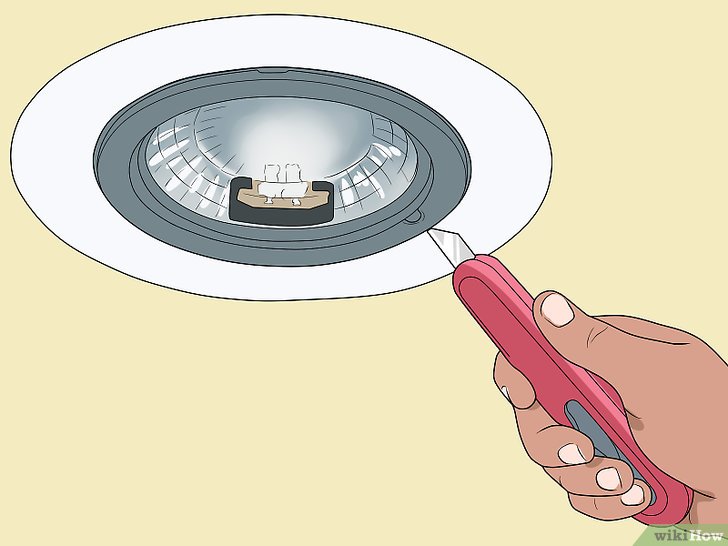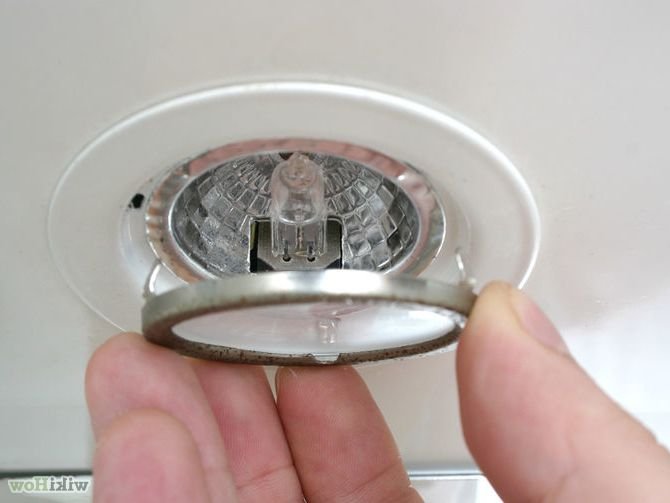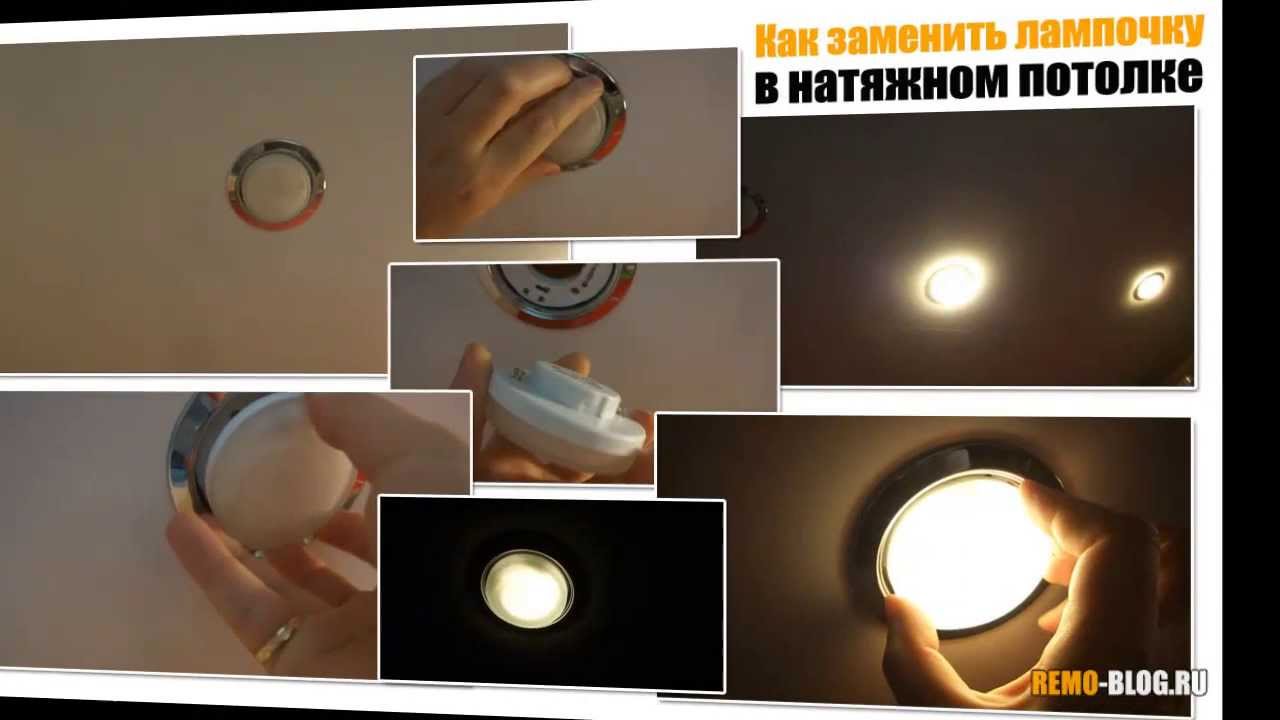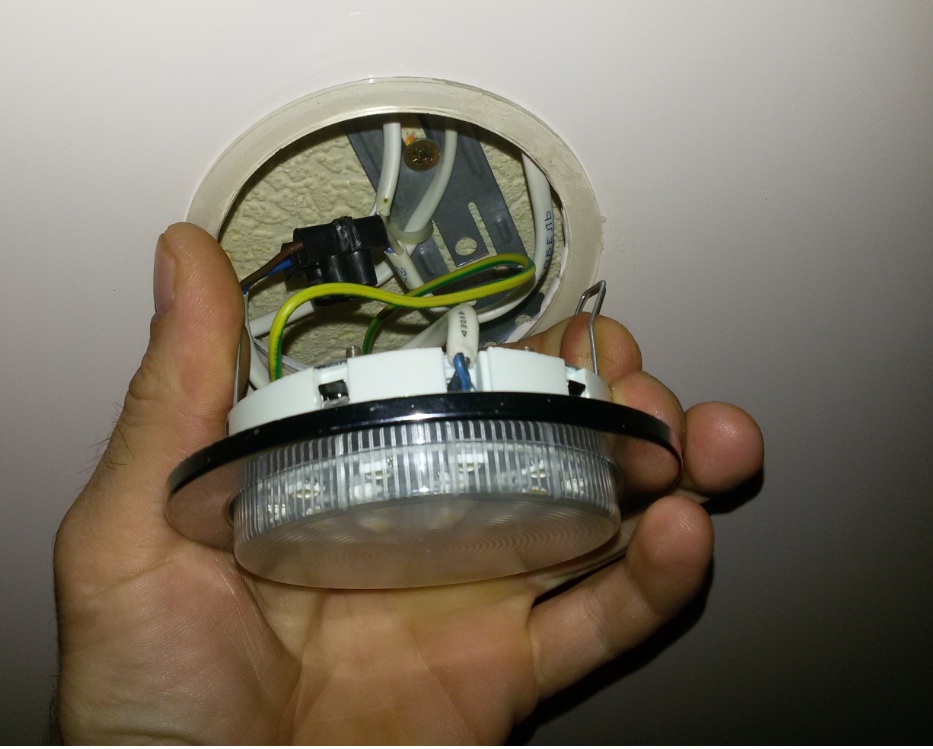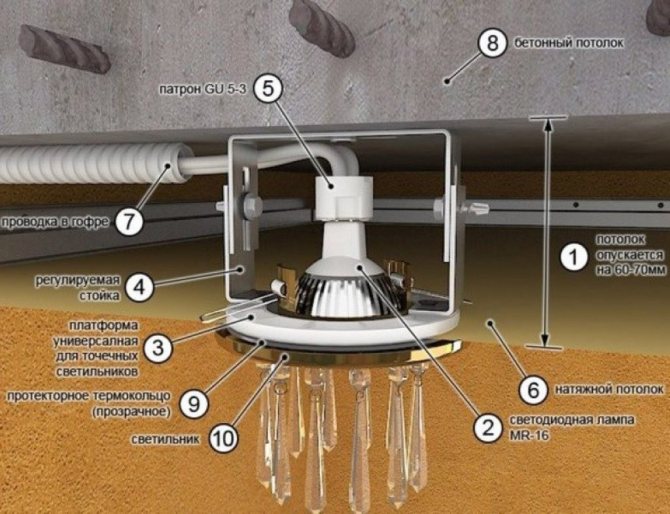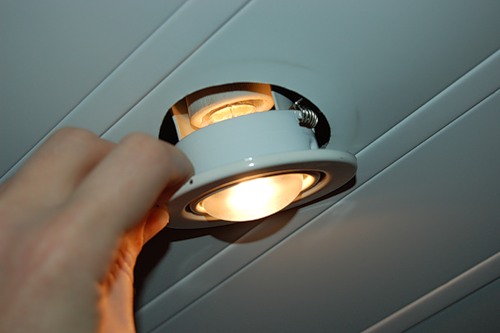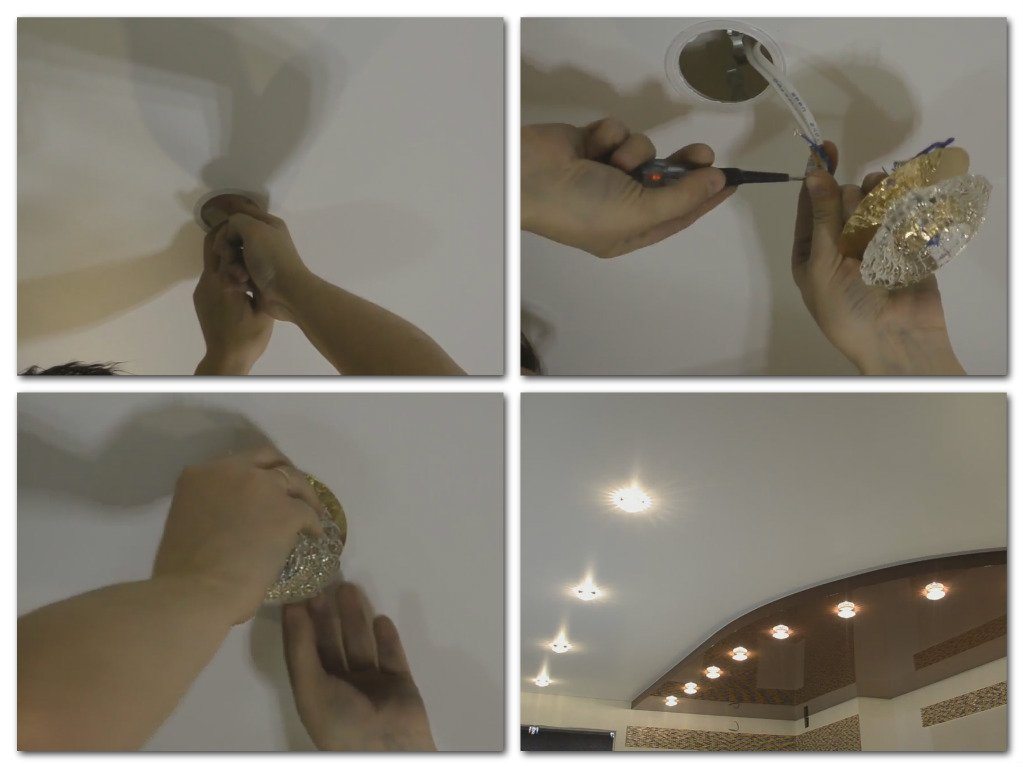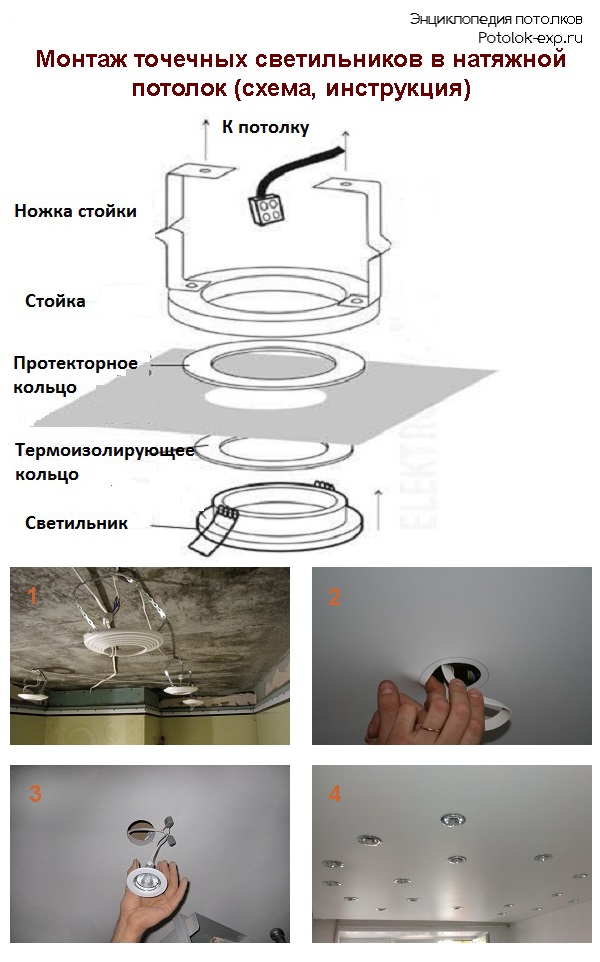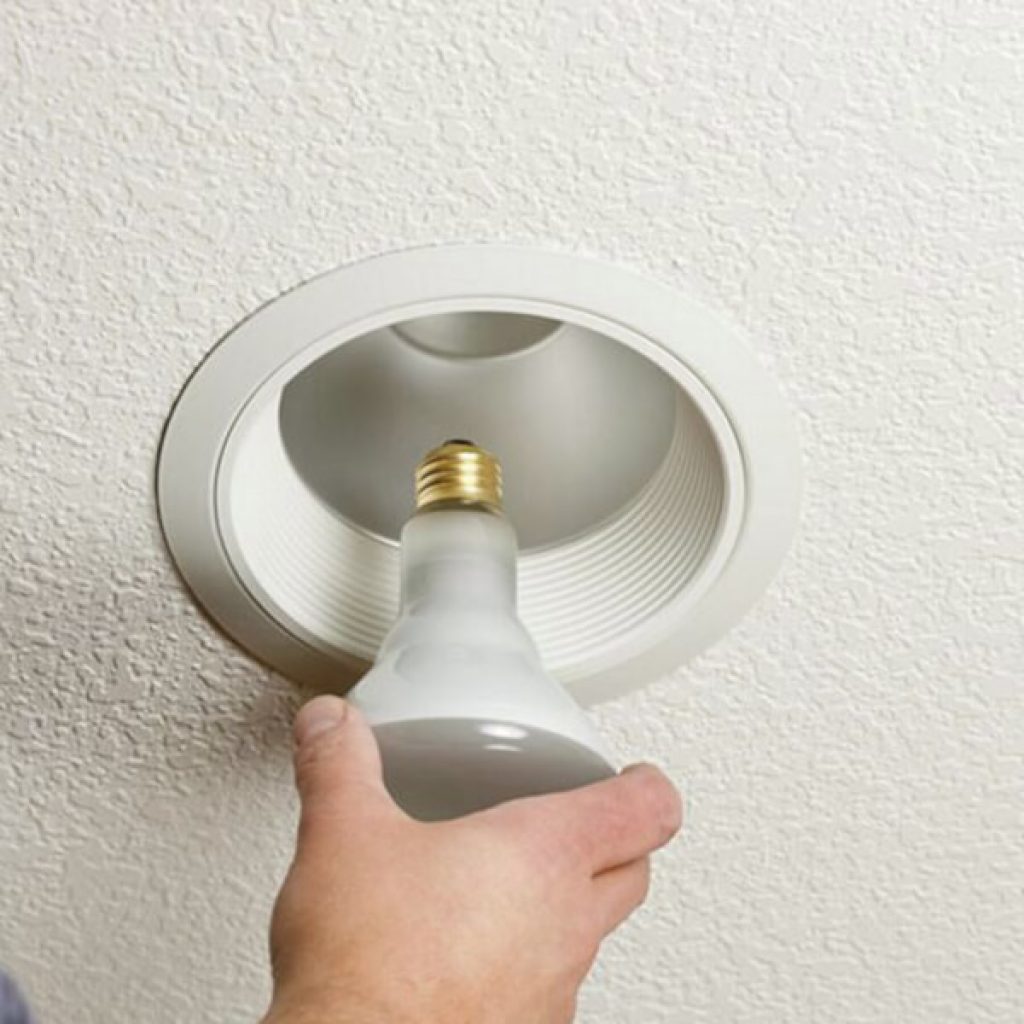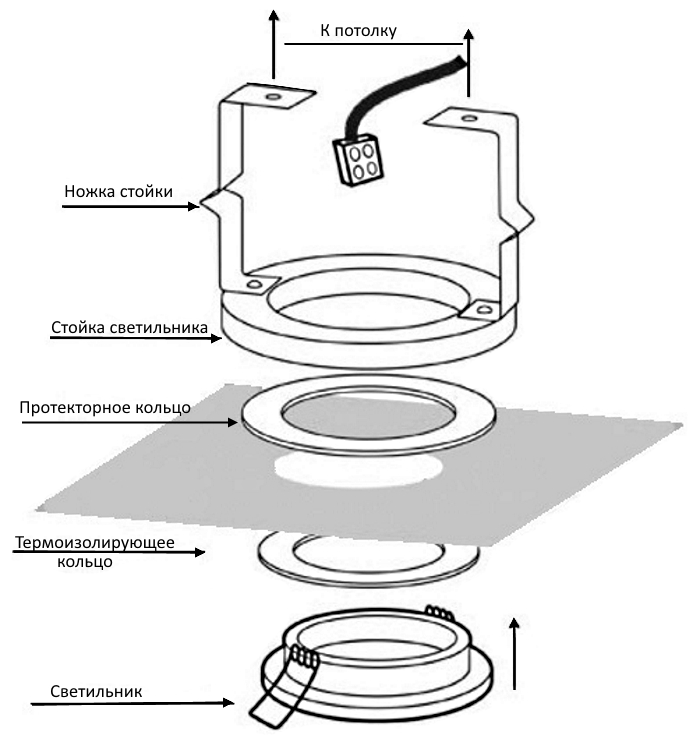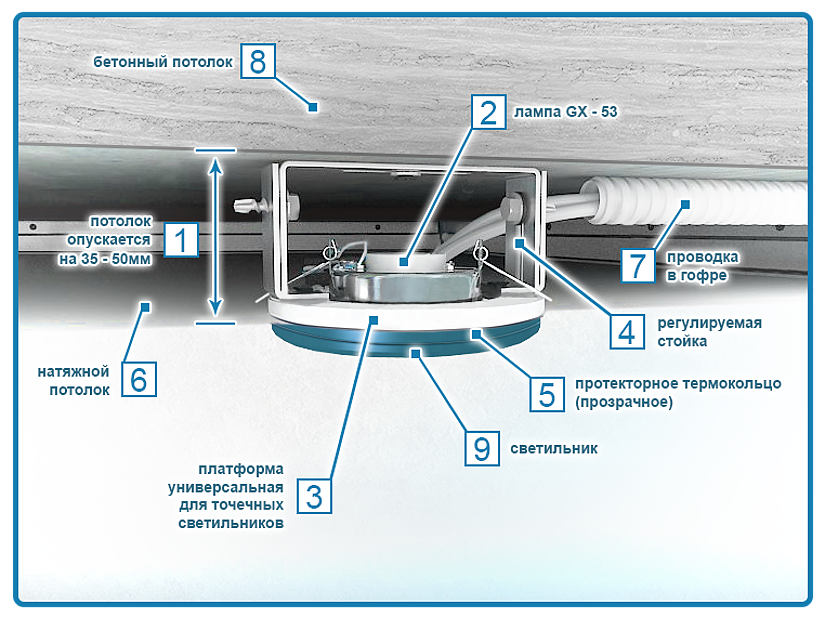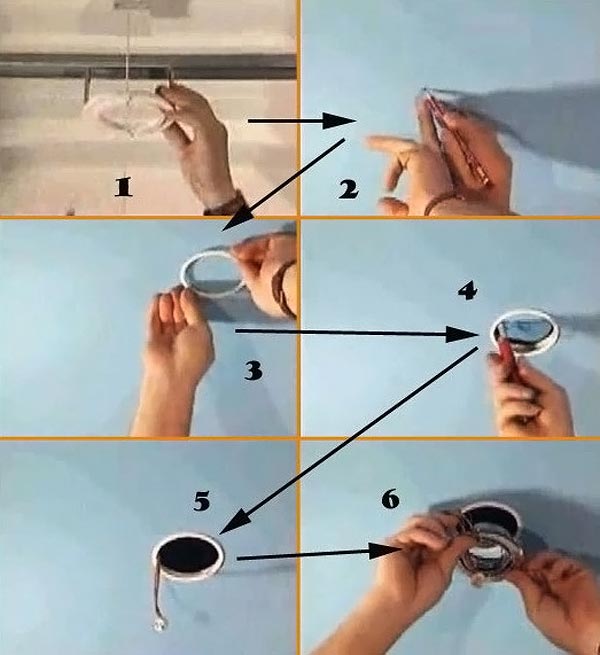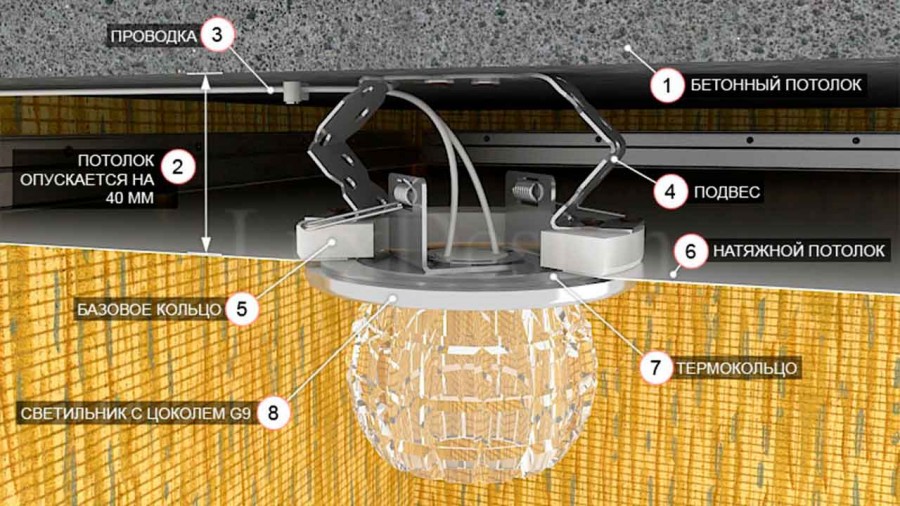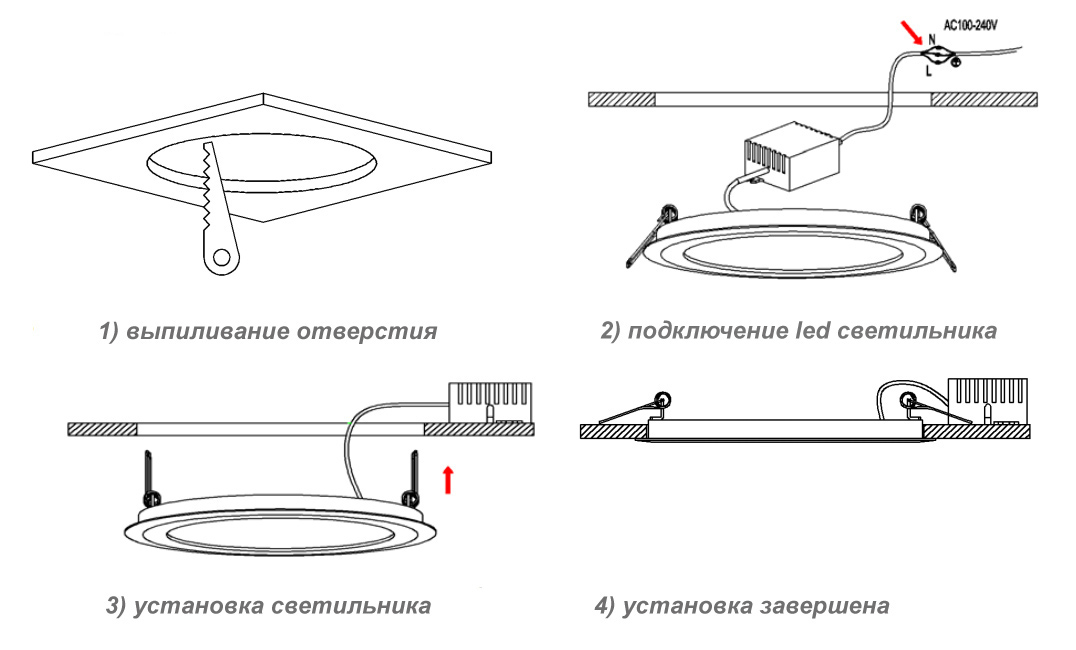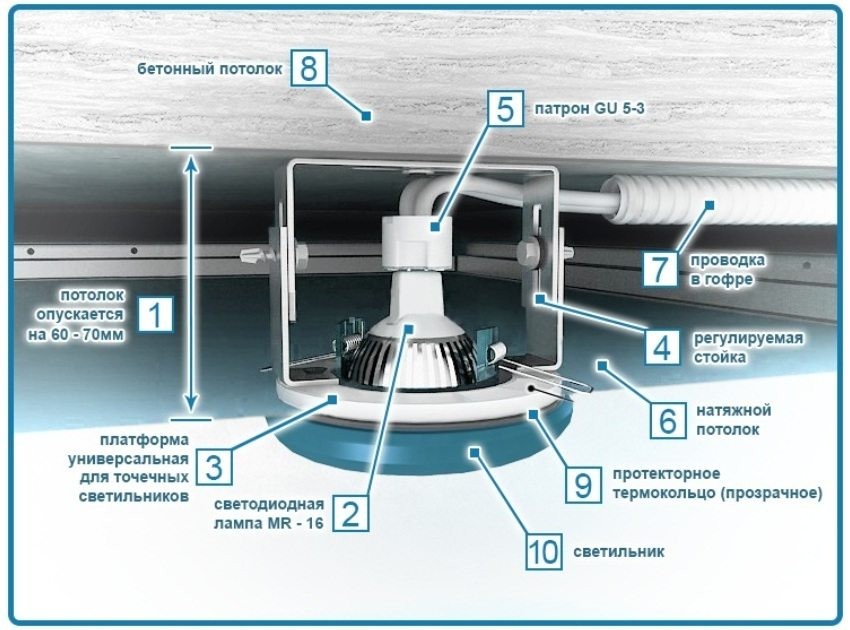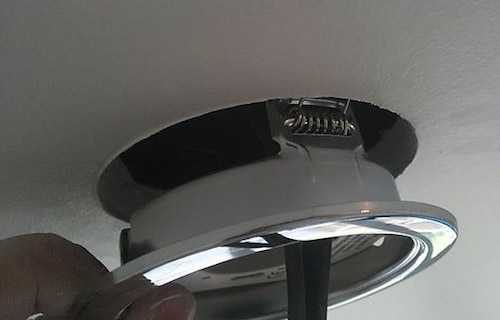Types of lamps used in stretch ceiling structures
 In stretch ceiling systems, several options for lighting devices can be used:
In stretch ceiling systems, several options for lighting devices can be used:
- Halogen. This type of lamp produces diffused light that is best perceived by the human eye. The halogen lamp can be installed with the smallest gap, and the service life of the appliance depends on whether the installation is correct. If you buy low-voltage elements, then they can be used in rooms with high humidity. However, this version of the lighting device does not tolerate sudden power surges, which is why it can fail much faster. It is just right to solve this issue with the help of a voltage stabilizer, which experts recommend to be sure to install. Replacing a failed halogen lamp, especially if it is built-in, is much more difficult than a conventional one. Performing the work in stages, every home craftsman will be able to cope with this task.
- Anyone can replace standard incandescent bulbs. After all, such work had to be done by everyone, without exception.
- LED lighting sources. By installing a high-quality LED lamp, for example, Ecola, in a spotlight, you can create very beautiful panoramic lighting, and this particular option is the most durable and economical.
- Energy saving option. Such models consume the least amount of electricity. However, experts do not recommend using an energy-saving lamp in rooms with high humidity. For example, in saunas or baths. The service life of such models directly depends on the number of on and off cycles, that is, the more often the lamp turns on and off, the shorter its service life will be.
Knowing what type of lighting fixture is used in a pendant structure, it is much easier to perform an independent replacement of a lamp that has become unusable.
How to change light bulbs in a stretch ceiling
As practice shows, in order to emphasize the beauty of PVC cloth, point lighting devices are used, which are placed in a certain order. Replacing a light bulb in an ordinary chandelier is quite simple, while things are much more complicated with PVC canvases. To remove the light bulb, you have to take out the entire device. The step-by-step algorithm of actions completely depends on the type of lamp used.
It is important to take into account the fact that often on sale you can find lighting devices with LEDs, which are one piece. In such cases, the entire device must be replaced.
Attention! If it becomes necessary to change a spotlight on a stretch ceiling or replace a light bulb, it is better to do this as soon as possible.

How to change an LED lamp in a stretch ceiling
Today, LED lamps are especially popular. This demand is due to the economy and fairly bright lighting.
To remove a lamp from a stretch ceiling, you should adhere to the following rules:
- check the serviceability of the lamp with a tester and turn off the electrical energy in the entire room;
- take care of the availability of autonomous lighting if the room is dark for installation;
- remove fasteners and remove insulation from electrical wires;
- replace the new lamp according to the instructions supplied with it;
- connect all wires, ensuring reliable insulation;
- install the luminaire cover.
Despite the fact that LED lamps also have to be changed periodically, they still remain more economical than other types.
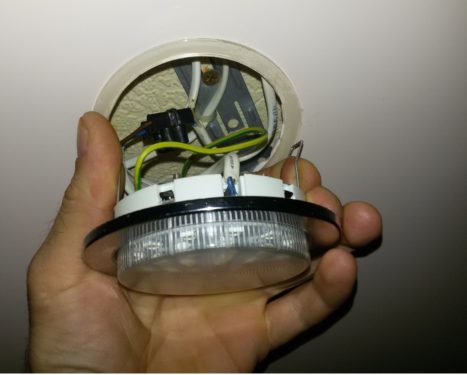
How to change a halogen lamp in a stretch ceiling
As practice shows, halogen lamps installed in lighting structures on PVC canvas are much more difficult to replace than other types. Despite the presence of some difficulties that can be encountered during work, halogen lamps have some advantages, among which the following points can be highlighted:
- such light sources emit a rather soft and pleasant luminous flux, which a person perceives well enough;
- the operational period is about 5 years, and if we compare the indicator with ordinary lamps, then this period is impressive.
Before unscrewing the light bulb in the stretch ceiling, you will need to turn off the electricity. After you have managed to gain access to the halogen lamp, you will need to remove the fasteners and carefully remove the lamp from the holder.
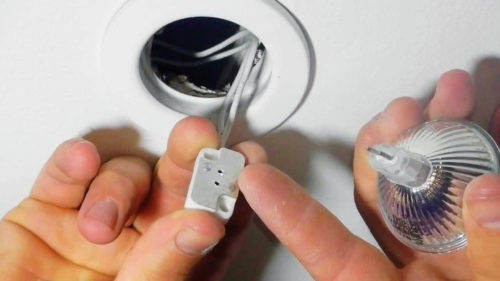
How to unscrew a stuck light bulb from a stretch ceiling
You can often face a problem when you need to remove a stuck light bulb from a stretch ceiling. Such problems are very common. In such situations, some effort is required to remove the flask. If that doesn't work, you can try using pliers.

How to change a light bulb in a stretch ceiling: video
As practice shows, to carry out work on replacing lamps in a luminaire, it is required to adhere to a certain step-by-step algorithm of work. If you cannot replace a light bulb in a stretch ceiling in this way, you can watch a video on this topic and clearly see all the stages of installation and dismantling of lighting fixtures on PVC canvas.
Replacement of GU5.3 and MR16 products in false ceilings
Lighting fixtures that are installed in suspended ceiling structures have two main parts:
- functional;
- decorative.
The functionality includes the frame and clamps.
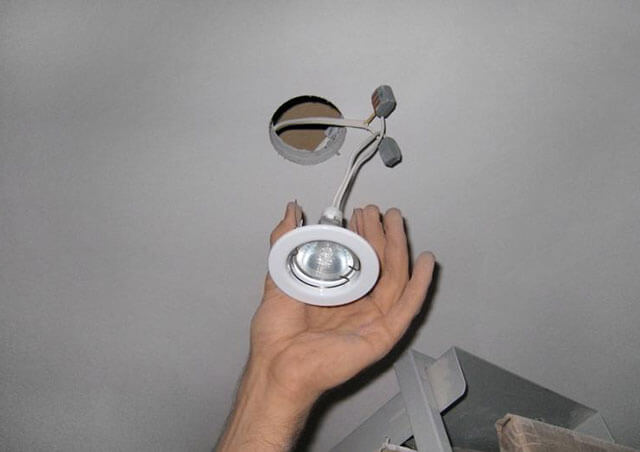
The replacement work consists of 4 stages:
- Voltage cut-off... First of all, you should de-energize the room where the replacement is to be done. For this purpose, turn off the automatic lighting circuit in this room. It is permissible to use a switch on the lamp, but one cannot be sure that it will break zero, and not the phase. The fact is that if the masters made a mistake when arranging the lighting, the phase wire will remain energized, even when the light is turned off. It is better not to put yourself at risk and to carry out all power outages directly in the panel.
- Removing a burnt out light bulb... First, the main retaining ring, which acts as a retainer, is removed. To do this, you need to remove two antennae, after which the light bulb itself falls out of the body, while it hangs on the contact holder. It is then removed from the contacts by turning the model GU10 counterclockwise or pulling the MR16 towards you.
- Installing a new lamp... Before replacing a light bulb in a false ceiling, it is necessary to check the power and voltage indicators on the new product with those on the burned out one. Lamps can have the same shape and different supply voltages. For example, instead of 220V, there will be 12V. The main thing is that the power corresponds to or does not exceed the previous value, otherwise overheating of the luminaire is likely to occur or, if a power supply is available, its overload. When all the data correspond, plug connectors are inserted into the contact sockets of the lamp to be installed, located on the socket.
- Replacing and fixing the lamp... A snap ring is used again. His ears are squeezed, placed in the grooves and released. After the light bulb is fixed, turn on the lighting.
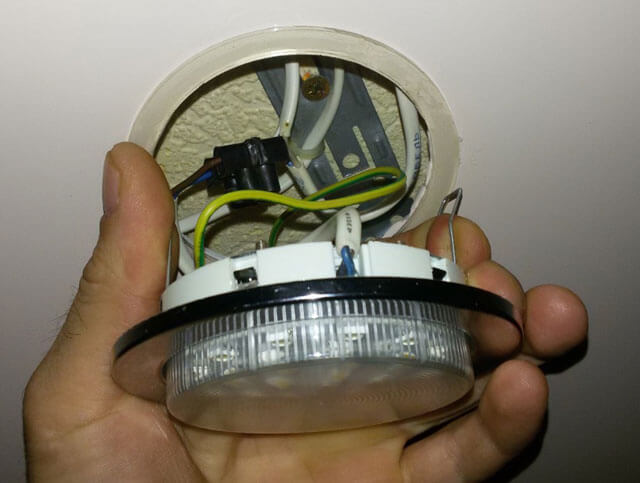
There are models that do not have retaining rings. In this case, before changing the LED lamp in the stretch ceiling, you will need to completely remove the lamp from the ceiling structure.
The reasons for this may be the following:
- the springs deformed the body of the lighting device;
- since the springs are of the wrong size, they begin to put excessive pressure on the body - this usually happens when several bulbs are replaced at the same time, when the rings are confused and installed in the wrong places;
- the ceiling structure is mounted at an insufficient distance from the ceiling and the lamp with the socket rests against the plaster.
How to change a light bulb in a spotlight on a stretch ceiling
Depending on the type of socket, the bulbs are removed in different ways. Let's consider in detail the replacement process for each type of base. Before starting work, it is better to de-energize the mains on the shield, otherwise it may cause electric shock.
G5.3
It is not very convenient to remove bulbs of this type from spots, since the outer part is recessed in the luminaire body and is located above the plane of the stretch ceiling. They are held in shades by means of a special retaining ring or a wire brace with antennae at the ends. These luminaires are compatible with LED and pin-type halogen elements.
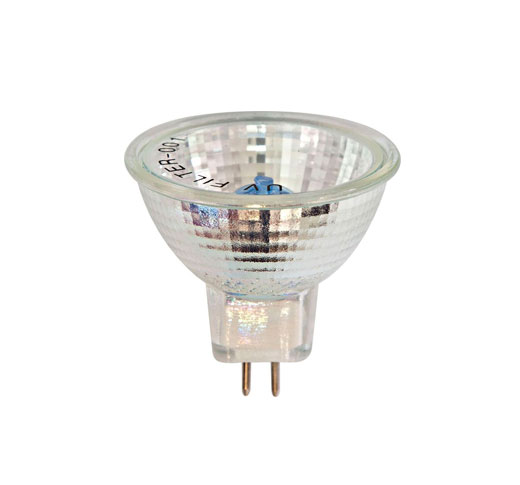
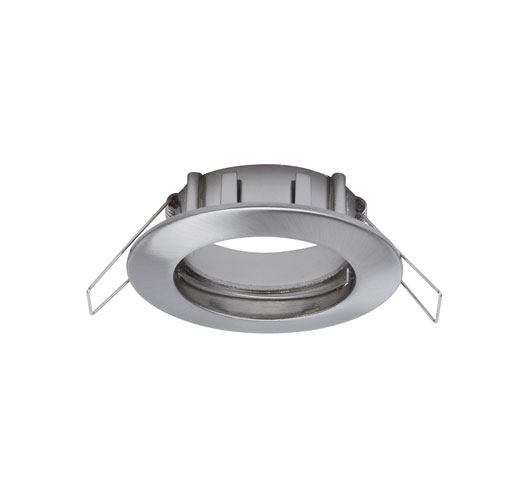
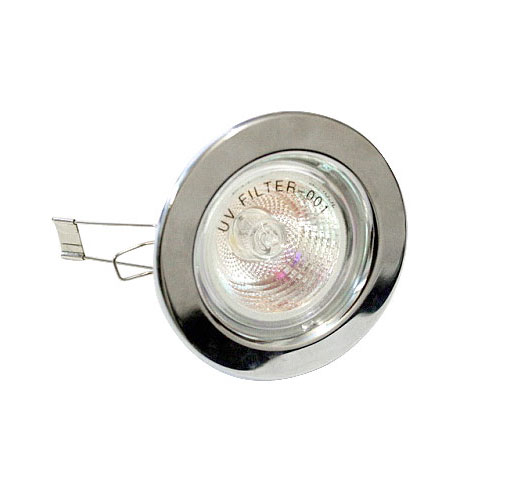
To change a light bulb with a G5.3 base, you need to squeeze two antennae and pull out the fixing bracket. If a retaining ring is used as a retaining part, it is simply unscrewed. The lamp falls out. Then it must be disconnected from the contacts by pulling it towards you. After that, a new lamp is connected, inserted into the luminaire body and the retaining ring is installed in place.
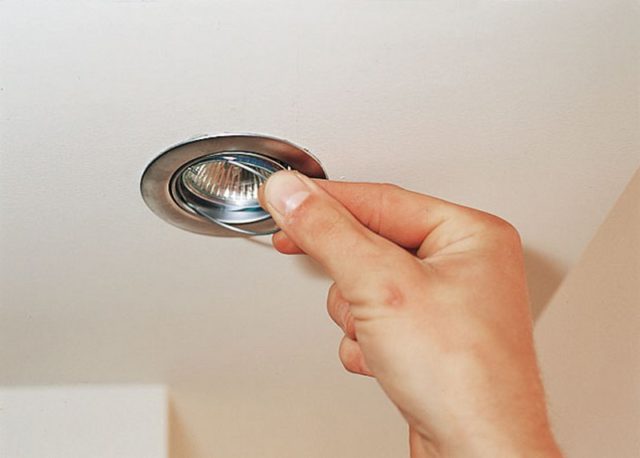
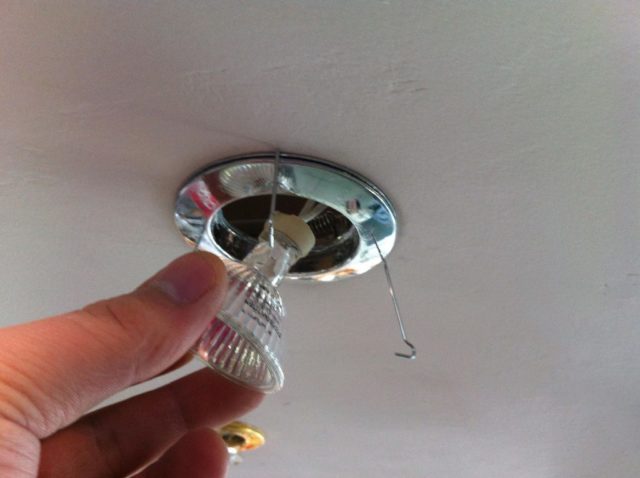


Sometimes the retaining ring does not fit back after replacing the bulb. This happens for several reasons:
- the case is deformed - it will have to be replaced;
- the ceiling is fixed too high and the base rests against the concrete base - it is necessary to purchase a lamp of exactly the same size, a 1 mm difference can cause a problem;
- the clamps of the wrong size - this happens if it was necessary to unscrew several bulbs and the rings were confused.
GX53
In luminaires for the GX53 base, the lamps protrude 3-4 mm beyond the ceiling. On their back side there are two pins-contacts, which are inserted into the corresponding grooves on the body of the lighting fixture. Dismantling is carried out by turning the lamp counterclockwise until it clicks, then it is simply pulled out.


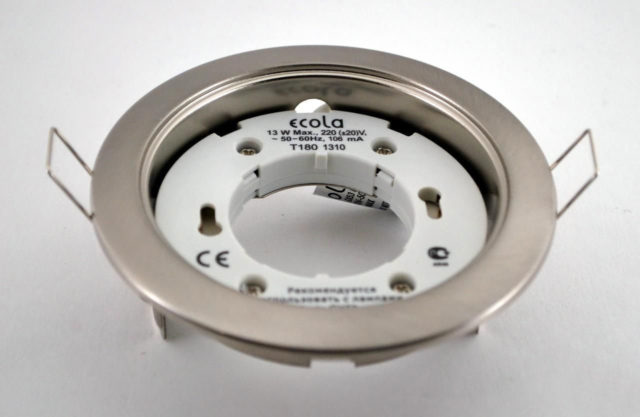
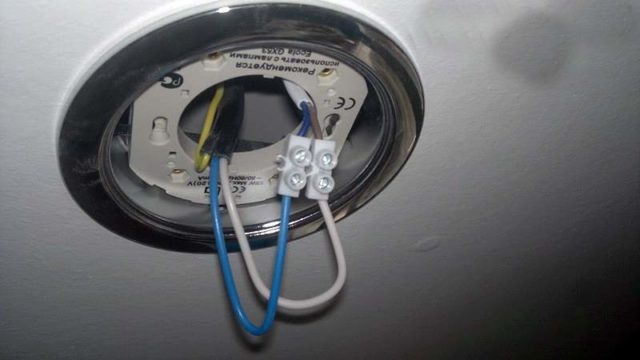
Replacement is very easy, and there is no need to install fixing parts or disconnect wires. Just insert a new lamp and turn clockwise.
G4, G9
The design feature of such lamps is that the body protrudes beyond the plane of the ceiling. LED and halogen pin-type models are available with G4 and G9 bases. To dismantle the lamp, just pull it down. Then just insert a new one into the groove. There is no need to turn the lamp. In some models, you first need to disassemble the spotlight, namely, unscrew the decorative diffuser.

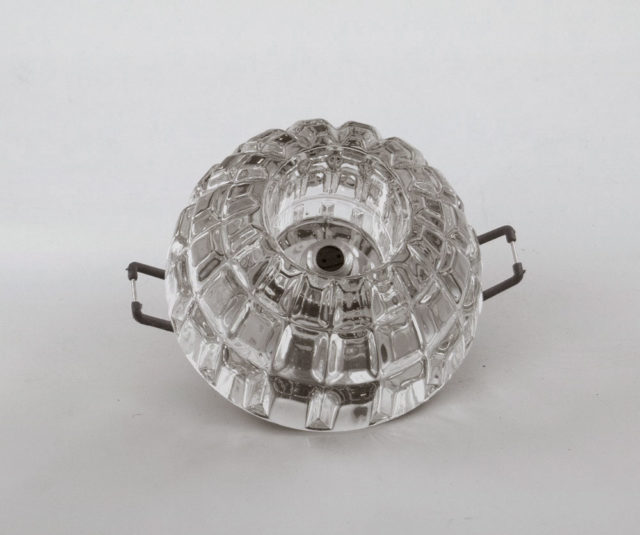

E14, E27
Such lamps are changed in the same way as in an ordinary chandelier or sconce.
Holding the flask, carefully unscrew it counterclockwise. Then screw in a new one all the way, but without effort
Sometimes the light bulb is difficult to grasp with your fingers, in which case you can use masking tape.

Types of luminaires and recommended lamp wattage
According to the installation method, point lighting devices are divided into two types:
- Embedded. The main part of the device is hidden behind the canvas. The bottom edge is at the same height as the ceiling and does not protrude beyond it. The overall level of the structure is slightly lowered because of this. With this arrangement, the spots are less noticeable, but the light flux is more narrowly directed. The lamp and the canvas around it heats up more and cools down longer.
- Overhead. The luminaire is fixed at the level of the ceiling, and the body is located below. When installed outdoors, the device is more noticeable, but it cools faster and illuminates the space more evenly. This type is safer to use.

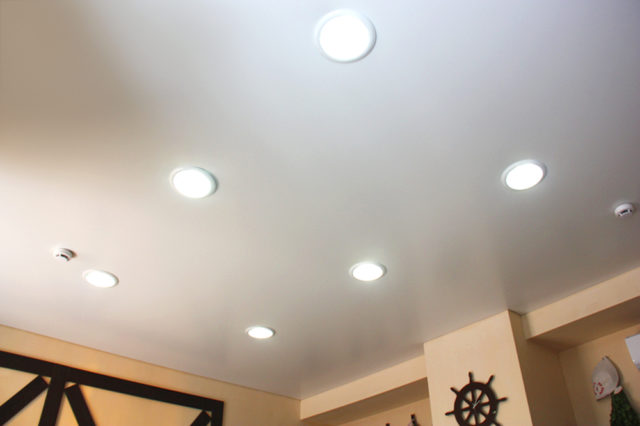
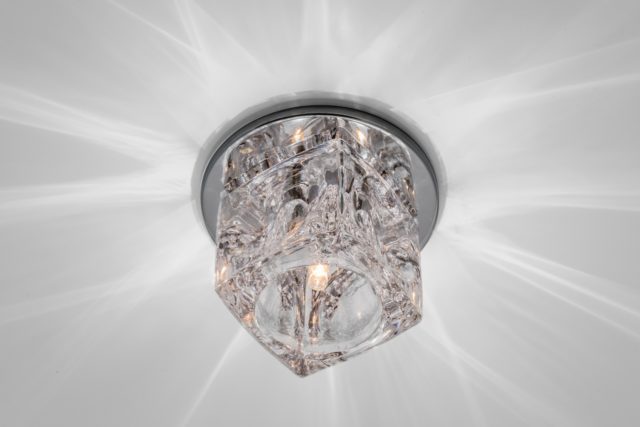
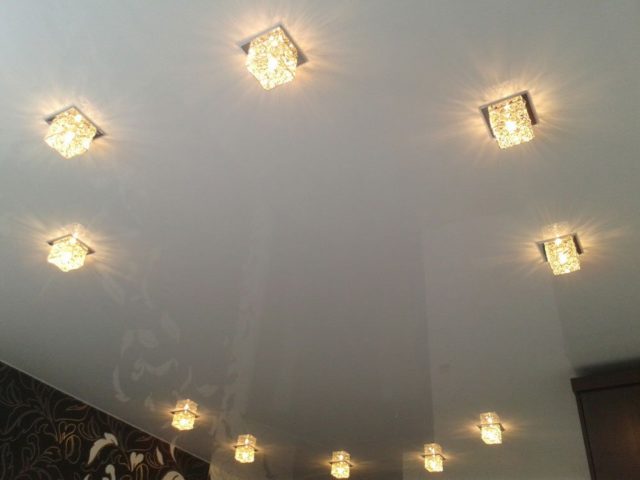
The body is made of different materials: glass, crystal, aluminum, plaster, plastic.The shape can be round, square or rectangular. To choose an appearance, take into account the general style of the room. It is advisable to purchase lamps designed specifically for stretch ceilings. They are designed in such a way that the rays do not shine through the canvas around. Plasterboard is a denser material, so false ceilings do not have such problems.
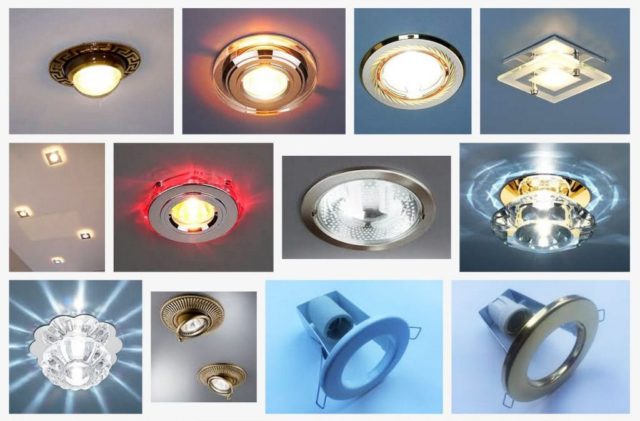
There are several types of bulbs:
- Incandescent lamps. Almost not used with a stretch ceiling, as they get very hot.
- Halogen. A relatively expensive option and also generate a lot of heat.
- Energy saving. They are convenient where constant lighting is required, and with frequent switching on they consume a lot of electricity.
- LED. Economical and durable, practically does not heat up.

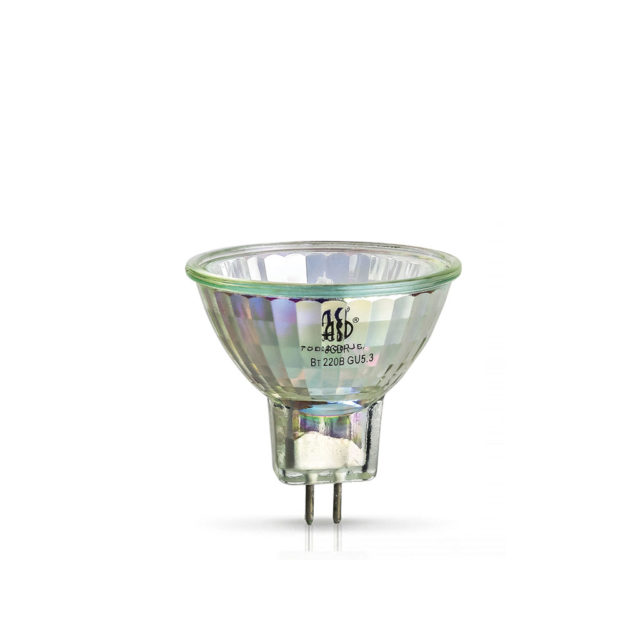
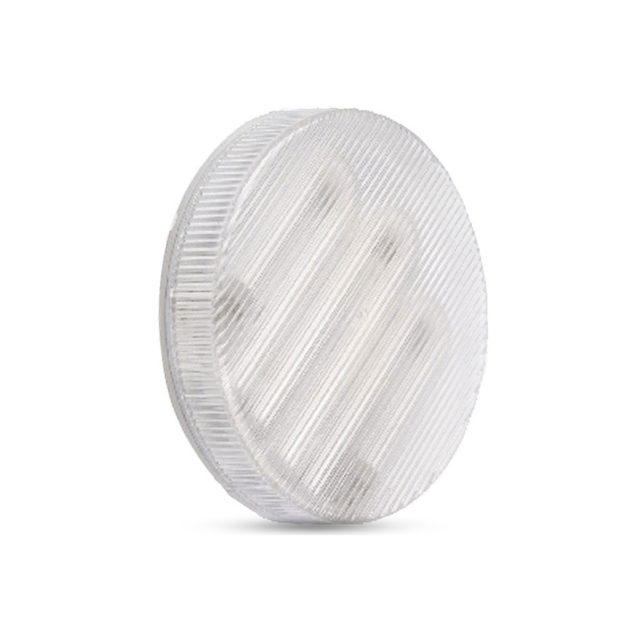

The most common types of plinths:
- G5.3 (for halogen and LED lamps);
- GX53 (led and energy saving);
- G9 (halogen and LED for surface-mounted luminaires).


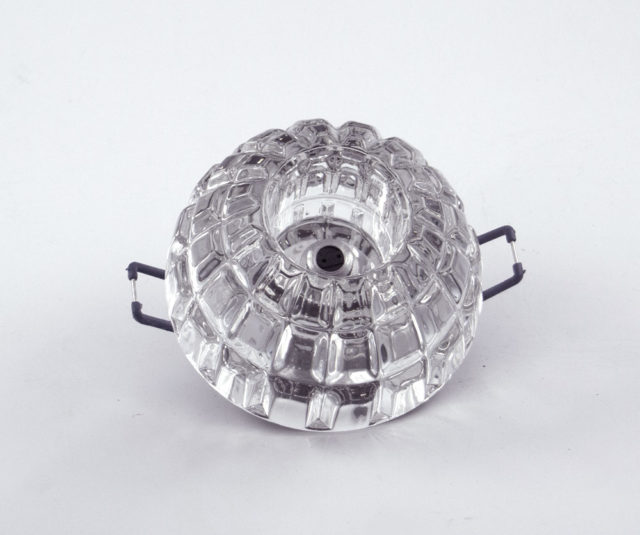
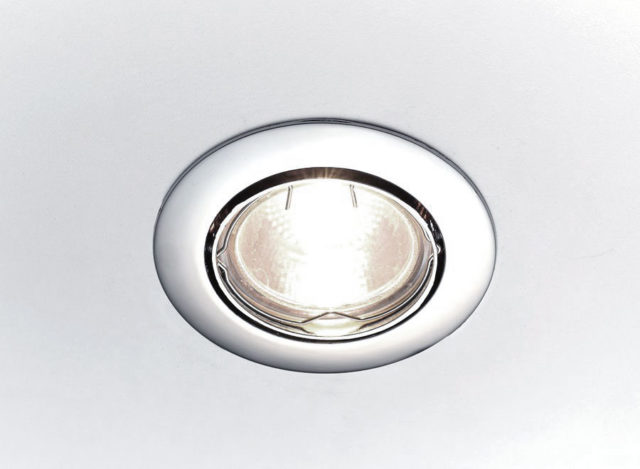
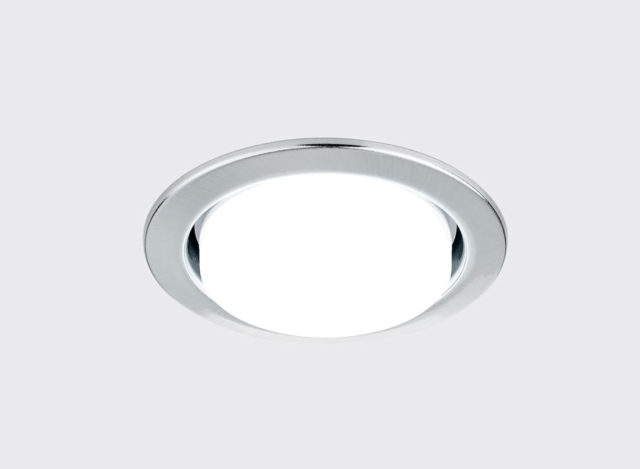
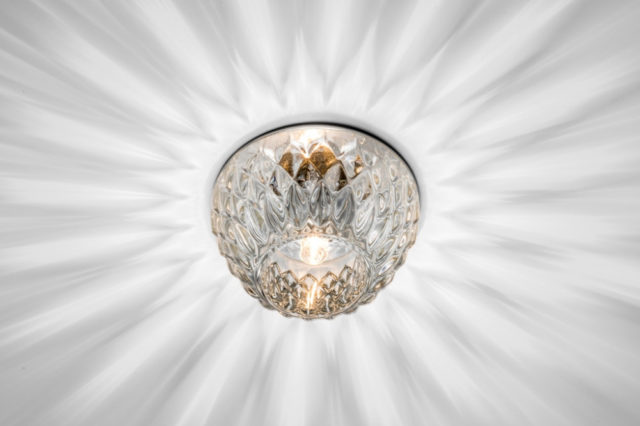
Previously, only 12V bulbs were produced. A transformer was required to connect to the power supply. Now there are lamps on sale that work directly from 220V.
Types and features
Before replacing a light bulb, you need to find out its type and purchase a new one. When choosing a luminaire, you will need to consider several characteristics.
Plinth
An important element of any light bulb is the base. The purpose of the element is to connect the conductive parts of the lamp and the corresponding socket. Lamps can have the same glass bulb, but differ in the type of cap.
The plinth marking is determined on the basis of an internationally accepted standard, which allows you to purchase the desired option knowing the combination of letters and numbers. The first letters in the marking indicate the shape of the base, and the numbers indicate the distance between the contacts, the diameter of the thread, or the outer dimensions of the base case.
Threaded
Threaded caps are often used in incandescent lamps and energy efficient lighting sources. This variety is known to many as the Edison base.
When choosing lamps with a threaded base, you need to pay attention to the numbers in the marking, which in this case determine the outer diameter of the thread
Pin
A type of pin base is designated by the Latin letter G. To connect the light bulb to the socket, a pin system is used. The numbers in the name indicate the gap between the central parts of the pins, and with a large number of pins, the diameter of the circle on which their centers are located.
Bayonet
This type of base has a modified design of the threaded element. The function of the thread is performed by the pins located on the lateral sides, on which the lamp is fixed in the holder. Depending on the manufacturer, the bayonet base is marked with the Latin letter B or the Russian W. Before the letter, the number of contacts is indicated, after the letter - the diameter of the case. Thanks to the precise fixing, the bayonet-base bulbs can be two- and three-pin.
Lamp type
In addition to the type of base, when replacing a light bulb in a stretch ceiling, you need to know its type. There are several types of lamps that have distinctive characteristics and features.
Incandescent
Incandescent lamps are the most common option and are light sources that emit a stream of light by heating a tungsten conductor. The refractory metal has a high melting point, which is why it is used in lighting fixtures. The filament is housed in a glass bulb filled with an inert gas to prevent oxidation. Low wattage incandescent lamps are produced without the use of inert gas. The advantages of this type include:
- affordable cost;
- instant inclusion;
- large power range.
In comparison with other varieties, several negative aspects can also be distinguished.For example, a short service life and low efficiency, since only a tenth of the consumed electricity is converted into light radiation.
Halogen
Halogen lamps are similar in design to standard incandescent lamps. Inside a large flask made of transparent or frosted glass, there is a thin tungsten filament surrounded by a gas mixture. As a result of the supply of current, the thread heats up to 2500 degrees. When heated, the tungsten filament glows white, but the illumination depends on the color of the bulb.
Luminescent
Fluorescent lamps are made in the form of an oblong glass tube, sealed on both sides. The inside of the tube is covered with a phosphor, and the space is filled with an inert gas. The lamp also contains a small amount of mercury, which heats up and creates mercury vapor. The glow of fluorescent lamps is based on the heating of the tungsten element and subsequent radiation, which is absorbed by a special compound, which causes bright light.
The high power of fluorescent light sources is possible due to the internal phosphor coating. With the same electricity consumption, the power is higher than that of incandescent lamps, therefore the luminescent type is also considered to be energy-saving.
LED
The main feature of the LED type of lamps is the reduced power consumption. Another advantage is the long service life, which can reach 100 thousand hours. LED products are capable of working with any voltage indicator and there is no need to additionally install ballast resistors.
Halogen lamps
Such lamps have recently become more and more popular. Still, they have plenty of advantages, but there are practically no shortcomings. They provide natural, diffused light that is easily perceived by the human eye. Of course, one halogen light bulb will not be able to provide the necessary lighting, but when united in a group, they create a full-fledged light source. The life of such lamps is on average 3-4 years, and if it fails at the end of the specified period, it will not be difficult to replace it.
So, how does the replacement of a halogen bulb take place:
- Disconnect electricity;
- Pull out the mount that secures the light bulb;
- carefully disconnect the bulb that is out of order from the socket;
- take a new lamp and attach it to the place of the one you pulled out;
- put the lamp in its original place and fix it with a special mount.
Now you know how to change a light bulb in a false ceiling, but before buying a new replacement, we advise you to unscrew the old bulb and take it with you to the store. So you can't go wrong when choosing the right model.
Since all types of lamps are identical in structure, the technology for replacing them is not particularly different. But still we offer you to watch a video about replacing a light bulb in a spotlight.
Previous articles from the category:
Options for the location of spotlights on the ceiling
Even the installation of the most fashionable chandelier model will not give you the perfect lighting effect, it will in any case attract the attention of others as much as possible, and some parts of the room will not be sufficiently illuminated. All this can be easily avoided by making the correct arrangement of spotlights on the ceiling.
Stretch ceiling lighting - photo gallery
The idea of stretch ceilings is rooted in antiquity, when ancient masters decorated the ceilings of nobles and kings with silk fabric. The stretch ceiling looked luxurious and mesmerizing. Today, when the lighting of stretch ceilings was invented, the most daring ideas have no boundaries - these are twinkling stars and the fiery sea of sunset ...
Installing a chandelier on a stretch ceiling
You decided to renovate, which in our time is already a small feat, but as a final chord, you wanted to install a stretch ceiling and suddenly the question arose of how to hang a chandelier on a stretch ceiling? But you really want a chandelier ...
Types of plinths
Regardless of what type of lighting device is used to illuminate the room: energy-saving, halogen, LED, incandescent type, you need to decide on the type of attachment. When choosing, the design of the luminaire is taken into account. In order to figure out how to change a light bulb in spots, you need to learn about the types of socles.
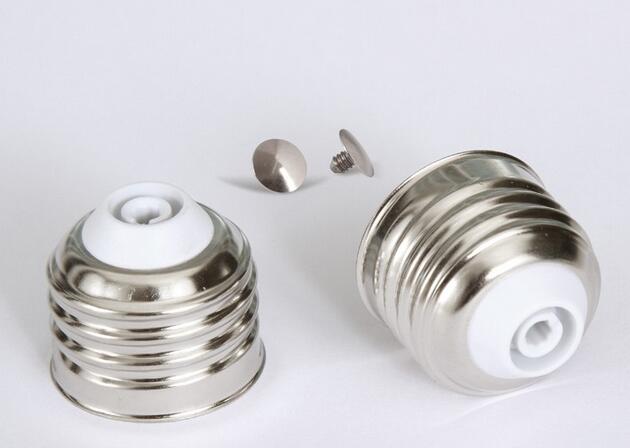
What is a plinth? This is the part of the light bulb that is used to hold the structure in the socket. In addition, it serves to conduct electricity. Without a base, the lamp will not work. Despite this, baseless devices are sometimes used. They are designed to conduct light in automotive applications.
The base design is simple: the body is made of metal or ceramic. Inside there are the elements of the light bulb, outside there are contacts for connection.
Each type is marked with letters and numbers. The letter means the type, the number means the characteristic.
Screw
The most common type for apartments is a screw base. It is marked with the letter "E". This is the oldest type of light source mount. Invented by Edison. The original name is "Edison Screw Type", or Edison screw type. Hence the letter "E". The number indicates the outer diameter.

Among all Edison sockets, the most common is E27. Lighting fixtures with a diameter of 27 are the most popular in Russian apartments, because it is easy to find a light bulb for them. E27 is equipped with traditional incandescent bulbs, but more recently they are found in halogen, fluorescent and LED.
E14 is also found on the market. They call him "minion". This type is most often found in sconces, table lamps, but sometimes in suspended and stretch ceilings. Less commonly use "E" with a diameter of 5, 10, 12, 26 and so on.
The main advantages are the prevalence and ease of fastening. There are no shortcomings.
Pin
This type of base does not use a screw, but a pin connection system. The numbers indicate the distance between the centers of the pins. Used in halogen and energy saving lamps. It is designated by the letter "G".

The G4 connection is used in small halogen bulbs. They are more often used for decoration, in spotlights, as well as in built-in lamps. There is a type G9. It is used in 220 V AC mains, suitable for decorative luminaires.
For office lighting, tubular G5s are used. For compact luminaires, there are four-pin base / plinths (2G10, 2G11). There are many such lamps. In order not to get confused when buying a new light bulb, it is recommended to take an old, burnt out light source with you.
In addition to the types described above, there is a type "GU". This means that the lamp is energy efficient. The most common ones for suspended ceilings are GU5.3. Their thickness is 2.7 centimeters.
Bayonet
This type of connection is also called bayonet or pin. The source is installed into the lighting fixture by inserting and scrolling. It is widely used for various purposes, most often in suspended, stretch ceilings and automobiles. The device operates in the presence of strong vibrations.
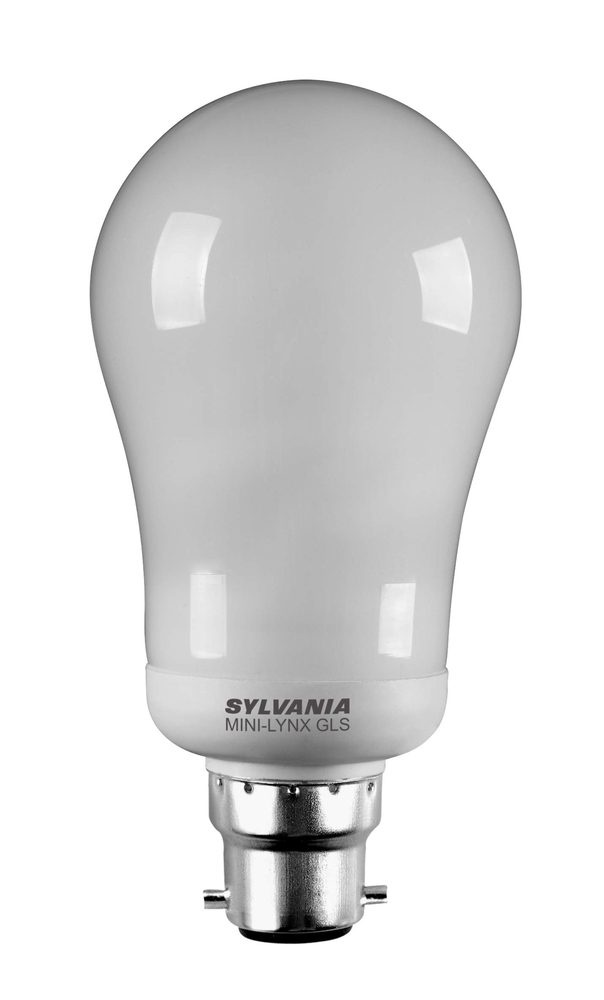
This type of connection between a lighting fixture and a light source is often used in vehicles and not only. For example, in the UK, this is the standard connector.
Bayonet fasteners are usually designated with the letter "B", and the number that follows the letter indicates the outer diameter of the connector.
There are bases with a different number of contacts (from 1 to 5). They are also indicated by the letter:
- "S" - single contact;
- "D" - double;
- "T" - three contacts;
- "Q" - four;
- "P" is five.
In everyday life, as a rule, lamps with one and two contacts are used. The rest are in production.
Lamp replacement recommendations
When replacing lamps on a stretch ceiling, always adhere to the following rules:
- always turn off the power supply to the lighting fixture;
- you need to make sure the integrity of the wiring and the reliability of the contacts;
- always consider what voltage they are designed for;
- in case of mechanical damage to the fluorescent lamp, it is necessary to carefully clean the remaining traces when broken from the walls and ceiling, because they contain mercury vapors;
- if the halogen lamp cannot be pulled out, then it is better to take out the entire lamp, after which it can be easily removed;
- it is necessary to familiarize yourself with the technical data and features of using certain types of light sources for a false ceiling in advance.
For information on how to replace a light bulb in a spotlight, see below.
The type of lamps used in the false ceiling
There are mainly four types of light bulbs used in the false ceiling.
Halogen. This view can be installed with the smallest space between the false ceiling and the main one. Halogen bulbs can light up a room quite brightly, and it is a little more difficult to replace it than a regular light bulb.
Care must be taken when replacing. The operating time of this type of lamp largely depends on the correct installation.
In the household network, frequent voltage drops occur, which do not affect the operation of the light source for the better. For this, it is recommended to use voltage stabilizing devices.
Conventional incandescent lamps. Each of us has known these products since childhood, and changing them is not difficult and knowledgeable. But ordinary lamps have one significant drawback, they heat up quickly and therefore are not suitable for all types of suspended ceilings.
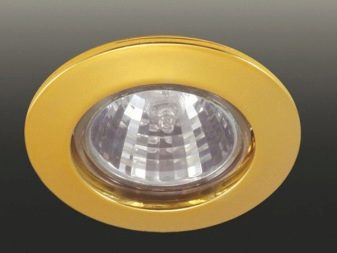
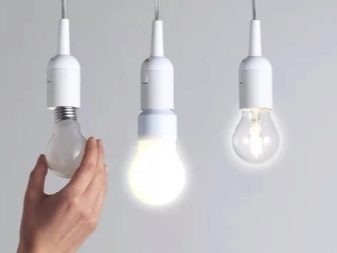
- Fluorescent lamps. This type of lighting fixtures, despite their high cost, has become widespread. They are very economical and consume the least amount of electricity, and their lighting performance is much higher than previous samples. They have a number of negative qualities - products with a hot start light up more slowly than other analogs, have a limitation on the number of turns on, off, and contain mercury vapors, which further complicates the disposal process.
- LED lamp. A more economical and long-lasting option for this type of ceiling. Their brightness sometimes surpasses those of luminescent products. The operating period of LED lamps reaches 72,000 hours of production, with a conventional lamp only 1000 hours.
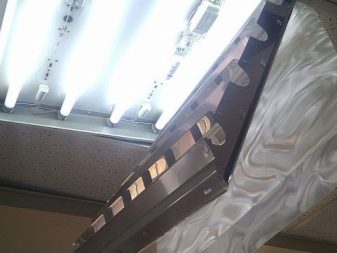
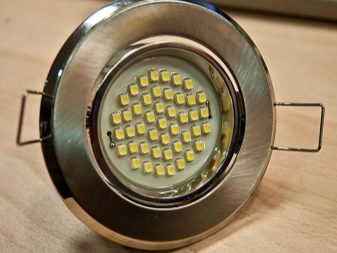
When changing different lamps, it must be taken into account that two types of caps are used for them. The first one is with a regular right-hand thread and is used for the classic chuck. Most of us know how to change a light bulb with this look. The second option is a G-shaped base with various types, the lamps are installed using the two pins available. These pins serve as a guiding function, and a firm attachment occurs after a characteristic click.

False ceiling as a light source
Before installing the suspended ceiling, a frame is assembled from wooden bars or from a metal profile, which are directly mounted to the concrete or wooden ceiling of the room. Then the ceiling covering itself is attached to the frame. For example, drywall can serve as a ceiling material for such a ceiling. But also such ceilings can be stretch, in which the ceiling covering is made of strong synthetic material. These structures perfectly hide all the defects of the main ceiling of the room and give it a smooth and smooth look.
Between these two ceilings (main and suspended), thanks to the assembled and fixed frame, a free space of up to 10 cm is formed. This empty space hides the electrical wiring for connecting future lighting and the main structural elements of the light source.To connect lamps and various light sources, special holes are made in such a ceiling. A distinctive feature of such a ceiling is the ability to install built-in lamps.
LED option
How to change an LED lamp in a stretch ceiling? It is believed that it is most profitable to install LEDs, since they consume little electricity. They also have a long service life. Such lamps are convenient and profitable, because they do not require high costs.
When the "pill" burns out, people ask how to change an LED light bulb in a stretch ceiling. This process will not take much time and effort, you just need to adhere to a certain algorithm of actions:
- It is necessary to turn off the electricity in the apartment.
- Do not forget about an additional light source, especially in the evening. A flashlight will not be superfluous when working on lamp replacement.
- First of all, the fasteners from the last lamp are removed.
- It is necessary to remove the insulation from the wiring.
- Disconnect the required wires carefully.
- You must first study the instructions that come with the new luminaire.
- A new LED lamp is installed in place of the old one.
- Connect the correct wires and attach a new light source. For this, special screws are taken.
According to the stores, most people purchase LED lamps to install in false ceilings. The demand for them is constantly growing.

Varieties of bulbs
- Incandescent light bulb - has the highest luminous power, is not too durable and heats up noticeably. However, its size, shape and power vary over a very wide range, so it is not difficult to change it. In addition, it tolerates voltage drops well and is not too sensitive to moisture: it can be used in the bathroom both in a regular chandelier and in the Armstrong suspended ceiling module.
- Metal halide - has excellent light output and much better color rendering, can generate beautiful daylight, and does not affect shades at all. The durability of the device is higher, but the sensitivity to voltage drops, especially in the acoustic range, is high.
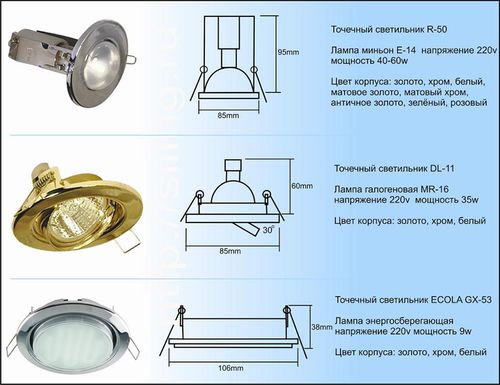
Before changing such a light bulb, you need to exactly determine its type. Devices are produced for a variety of purposes up to working in a specific position.

Installed without restrictions in any type of luminaire, including suspended ceilings. This is the most economical type of lighting, but it is also sensitive to voltage drops and moisture: they are not used in the bathroom. The photo shows a spotlight.
LED - have all of the above advantages and are devoid of all disadvantages: they are slightly inferior in light output to luminescent ones, they perfectly tolerate the effects of weather factors, are extremely durable, do not heat up and are completely safe. Can be used both in the bathroom and outdoors. There is only one thing - the cost.
Replacing an LED fixture is as easy as replacing a regular LED fixture.

Light source replacement steps
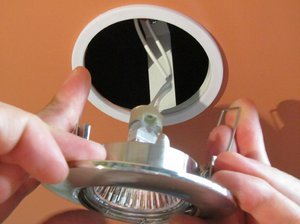 First, you need to get the luminaire by removing the retaining ring with which it is fixed in the ceiling. To do this, you need to carefully pick up the antennae, take out the ring and put it aside, as it will be needed for re-installation. Then, depending on the type, you should carefully pull out or unscrew the bulb from the socket, holding it with your free hand. Regular and halogen bulbs simply twist out. If it collapses, then you should collect the fragments, and then unscrew the base with pliers, making sure that the cartridge is not damaged. In this case, it is also necessary to choose the correct size of the base.
First, you need to get the luminaire by removing the retaining ring with which it is fixed in the ceiling. To do this, you need to carefully pick up the antennae, take out the ring and put it aside, as it will be needed for re-installation. Then, depending on the type, you should carefully pull out or unscrew the bulb from the socket, holding it with your free hand. Regular and halogen bulbs simply twist out. If it collapses, then you should collect the fragments, and then unscrew the base with pliers, making sure that the cartridge is not damaged. In this case, it is also necessary to choose the correct size of the base.
Before installation, it is necessary to correctly determine the power and operating voltage of the lamp in order to ensure the desired level of illumination.It is necessary to check the data of both lighting devices and their packages, since, for example, there are LED lamps with a GU 5-3 base, designed for 12 and 220 volts. The power of the new source should be the same or slightly less than that of the old one. Otherwise, the luminaire may overheat, and the power supply provided by its design may burn out. Do not handle the bulb of halogen lamps with dirty hands - this significantly reduces their service life.
After a successful check, you can insert or screw the lamp into the socket. Then you should install the spotlight in its place. After that, you need to take the retaining ring, squeeze its ears, insert the ends into the grooves and release. After making sure that the lamp is securely fixed, you can supply electricity to the house and turn on the light.

